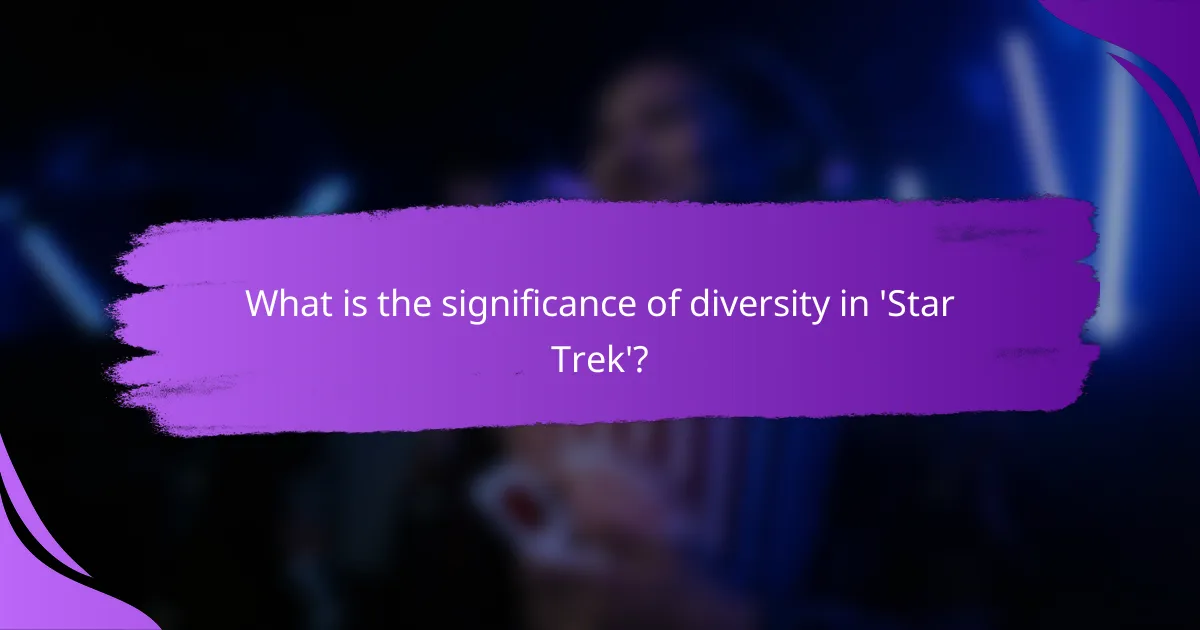‘Star Trek’ is a significant cultural entity that has influenced scientific inspiration, diversity, and visions of future societal structures. The series popularized advanced technology concepts, such as communicators akin to modern smartphones, and inspired real-world scientific pursuits in fields like robotics and artificial intelligence. It promotes inclusivity through its diverse cast, challenging stereotypes and advocating for equality, which has impacted societal views on race and gender. Furthermore, ‘Star Trek’ envisions a future with egalitarian societal structures, where cooperation among diverse species fosters unity and addresses themes of tolerance and social justice. This article explores these dimensions of ‘Star Trek’, highlighting its role in shaping scientific endeavors and societal values.

How has ‘Star Trek’ influenced scientific inspiration?
‘Star Trek’ has significantly influenced scientific inspiration by popularizing advanced technology concepts. The series introduced ideas like communicators resembling modern smartphones. It showcased the potential of space exploration and interstellar travel, inspiring real-world scientific endeavors. Many scientists cite ‘Star Trek’ as a catalyst for their career choices. The show’s depiction of diverse cultures and collaboration has encouraged interdisciplinary research. Concepts from ‘Star Trek’ have led to developments in fields such as robotics and artificial intelligence. NASA has referenced ‘Star Trek’ in its outreach to engage young minds in STEM fields. The series has sparked discussions on ethics in technology and space exploration.
What specific scientific advancements have been inspired by ‘Star Trek’?
‘Star Trek’ has inspired several significant scientific advancements. One notable advancement is the development of mobile communication devices. The original series featured communicators resembling modern flip phones. This concept influenced the design of early mobile phones.
Another advancement is the concept of tablet computers. The PADDs (Personal Access Display Devices) in ‘Star Trek’ resemble today’s tablets. This idea contributed to the evolution of portable computing technology.
Additionally, ‘Star Trek’ inspired advancements in medical technology. The show’s use of the tricorder influenced real-world medical diagnostic devices. Researchers have developed prototypes that mimic its functionality.
Furthermore, the series introduced the concept of virtual reality. The Holodeck has inspired developments in immersive virtual environments. This has applications in gaming, training, and therapy.
Finally, ‘Star Trek’ has also impacted space exploration technology. The idea of warp drive has spurred theoretical research into faster-than-light travel. Scientists like Miguel Alcubierre have explored this concept in their work.
These advancements showcase ‘Star Trek’s’ influence on technology and innovation across multiple fields.
How did ‘Star Trek’ portray technology that became reality?
‘Star Trek’ portrayed technology that became reality through its imaginative depiction of futuristic innovations. The series introduced concepts like communicators resembling modern mobile phones. It featured tablet-like devices that anticipated today’s touchscreen technology. The show also depicted advanced medical devices, similar to MRI machines, which are now commonplace. Additionally, ‘Star Trek’ showcased artificial intelligence through characters like Data, reflecting current advancements in AI. The series inspired real-world innovations, such as the development of the flip phone, influenced by its communicators. NASA and various tech companies have cited ‘Star Trek’ as an inspiration for their projects. The show’s vision of technology continues to resonate in today’s scientific advancements.
What role did ‘Star Trek’ play in promoting STEM careers?
‘Star Trek’ significantly promoted STEM careers by inspiring interest in science and technology. The series showcased advanced technologies and scientific concepts, sparking curiosity among viewers. It featured diverse characters in scientific roles, encouraging underrepresented groups to pursue STEM fields. Numerous scientists and engineers credit ‘Star Trek’ as a catalyst for their career choices. For instance, NASA has noted that the show inspired many to enter aerospace and engineering. The portrayal of futuristic technology, like communicators and tricorders, predicted real-world advancements. ‘Star Trek’ fostered a culture of innovation and exploration, motivating generations to engage in STEM.
Why is ‘Star Trek’ considered a cultural touchstone for innovation?
‘Star Trek’ is considered a cultural touchstone for innovation because it has inspired real-world technological advancements and scientific exploration. The series introduced concepts like communicators, which foreshadowed mobile phones. It also showcased diverse characters in leadership roles, promoting inclusivity and representation. The show’s optimistic vision of the future encouraged scientific curiosity and exploration. Notably, NASA has cited ‘Star Trek’ as an influence on its missions and goals. The series has sparked discussions on ethics, society, and technology, shaping public perception of science. Its legacy continues to inspire inventors and thinkers today.
How has ‘Star Trek’ shaped public perception of science and technology?
‘Star Trek’ has significantly shaped public perception of science and technology by popularizing futuristic concepts. The series introduced advanced technologies like communicators and replicators. These ideas inspired real-world innovations, including mobile phones and 3D printing. ‘Star Trek’ also presented a vision of a united, diverse future. This encouraged interest in space exploration and scientific careers. The show’s portrayal of science as a collaborative effort influenced public attitudes toward STEM fields. Its optimistic view of technology fostered a belief in progress and exploration. Overall, ‘Star Trek’ has acted as a catalyst for both imagination and real scientific advancements.
In what ways have ‘Star Trek’ creators collaborated with scientists?
‘Star Trek’ creators have collaborated with scientists through various initiatives. They have engaged scientific experts as consultants for accurate portrayals of technology and science. Notably, physicist Kip Thorne contributed to the depiction of black holes in ‘Star Trek: Voyager’. The franchise has also inspired real scientific advancements, such as the development of communication technologies similar to those seen in the series. Additionally, ‘Star Trek’ has hosted events like the “Star Trek Science Conference,” bringing together creators and scientists to discuss scientific concepts. This collaboration has fostered public interest in science and technology. The show’s influence has led to educational programs aimed at inspiring future generations in STEM fields.

What is the significance of diversity in ‘Star Trek’?
Diversity in ‘Star Trek’ is significant as it promotes inclusivity and understanding among different cultures. The series features a diverse cast representing various races, species, and backgrounds. This representation challenges stereotypes and encourages viewers to embrace differences. ‘Star Trek’ showcases cooperation between diverse characters to solve complex problems. For instance, the crew of the USS Enterprise includes humans, Vulcans, and Klingons working together. This collaborative spirit highlights the value of unity in diversity. The show’s portrayal of equality and acceptance influenced societal views on race and gender. It inspired real-world movements for civil rights and equality. Overall, ‘Star Trek’ serves as a powerful narrative advocating for diversity and its positive impact on society.
How did ‘Star Trek’ challenge societal norms regarding diversity?
‘Star Trek’ challenged societal norms regarding diversity by featuring a racially and culturally diverse cast. The original series, which aired in the 1960s, included characters of various ethnicities and backgrounds. Notably, it was one of the first shows to depict an interracial kiss on television between Captain Kirk and Lieutenant Uhura. This representation was groundbreaking during a time of significant racial tension in the United States. The series promoted the idea of unity and cooperation among different species and cultures in a futuristic setting. It encouraged viewers to envision a society where diversity was not only accepted but celebrated. ‘Star Trek’ influenced future media portrayals of diversity by setting a precedent for inclusive storytelling.
What diverse characters and cultures were represented in ‘Star Trek’?
‘Star Trek’ represented a wide array of diverse characters and cultures. The series featured characters from various ethnic backgrounds, including African American, Asian, and Hispanic actors. Notable characters include Lieutenant Uhura, a Black woman, who broke racial barriers in the 1960s. The Vulcans, with their logical culture, and Klingons, known for their warrior society, showcased fictional cultures with rich histories. The inclusion of these characters promoted themes of unity and cooperation among different species. ‘Star Trek’ emphasized the importance of diversity and understanding in its narrative. This representation influenced societal views on race and inclusion during its airing and beyond.
How has ‘Star Trek’ influenced representation in media?
‘Star Trek’ has significantly influenced representation in media by promoting diversity and inclusivity. The original series, which aired in 1966, featured a racially diverse cast, including Nichelle Nichols as Lieutenant Uhura. This was groundbreaking for its time, showcasing a black woman in a position of authority.
The show addressed social issues such as racism and gender equality through its storylines. For example, the episode “Plato’s Stepchildren” featured one of the first interracial kisses on American television. This act challenged societal norms and sparked conversations about race relations.
‘Star Trek’ also introduced strong female characters, paving the way for future representations of women in science fiction. Characters like Captain Janeway in ‘Star Trek: Voyager’ became role models for female leadership.
The franchise has continued to evolve, with recent series emphasizing [censured] representation. ‘Star Trek: Discovery’ features a prominent same-[censured] relationship, reflecting broader societal changes.
Overall, ‘Star Trek’ has set a precedent for diverse representation in media, influencing numerous shows and films that followed. Its legacy continues to inspire creators to prioritize inclusivity in storytelling.
Why is diversity important in the context of ‘Star Trek’?
Diversity is important in the context of ‘Star Trek’ because it promotes inclusivity and understanding among different cultures. The series showcases a future where various species and cultures coexist peacefully. This representation encourages viewers to embrace differences and challenge societal norms. ‘Star Trek’ features a diverse cast, including characters of various ethnicities, genders, and backgrounds. For example, Lieutenant Uhura, played by Nichelle Nichols, broke racial barriers in the 1960s. The show also explores themes of cooperation and teamwork across cultures. This diversity serves as a model for real-world societal structures. It highlights that collaboration leads to progress and innovation. Through its narrative, ‘Star Trek’ inspires audiences to envision a more inclusive future.
What messages about inclusivity does ‘Star Trek’ convey?
‘Star Trek’ conveys strong messages about inclusivity through its diverse cast and storylines. The series features characters from various ethnicities, genders, and species. This representation promotes the idea that diversity enriches society. It challenges stereotypes and emphasizes equality among all beings. For example, Lieutenant Uhura broke racial barriers in the 1960s as a prominent Black female character. The show also addresses social issues like sexism and discrimination. Episodes often highlight cooperation and understanding across different cultures. Overall, ‘Star Trek’ advocates for a future where inclusivity is fundamental to progress and exploration.
How has ‘Star Trek’ inspired real-world social movements?
‘Star Trek’ has inspired real-world social movements by promoting ideals of diversity and equality. The series featured a racially diverse cast and addressed social issues such as racism and sexism. For example, the character Uhura, portrayed by Nichelle Nichols, broke racial barriers on television in the 1960s. This representation encouraged civil rights activists, including Martin Luther King Jr., who urged Nichols to continue her role. Additionally, ‘Star Trek’ advocated for gender equality, showcasing strong female characters in leadership roles. The show also inspired movements for [censured] rights, as it portrayed relationships and characters that challenged traditional norms. Overall, ‘Star Trek’ has served as a cultural touchstone that reflects and influences social progress.

How does ‘Star Trek’ envision future societal structures?
‘Star Trek’ envisions future societal structures as egalitarian and diverse. The franchise depicts a post-scarcity society where resources are abundant. This allows for the elimination of economic inequality and poverty. In ‘Star Trek’, individuals are motivated by personal growth and the betterment of society. The United Federation of Planets exemplifies a cooperative interstellar government. It promotes unity among different species and cultures. The series often explores themes of tolerance and understanding. This reflects an idealized vision of human potential and cooperation. Through its narrative, ‘Star Trek’ inspires real-world discussions on social justice and equality.
What are the key societal themes explored in ‘Star Trek’?
‘Star Trek’ explores key societal themes such as diversity, equality, and the consequences of war. The series promotes the idea of a united federation, showcasing cooperation among different species. It addresses issues of racism and sexism through its diverse cast and storylines. The portrayal of advanced technology raises questions about ethical implications and societal impacts. Additionally, ‘Star Trek’ examines the balance between individual rights and collective security. It reflects on the importance of diplomacy over conflict resolution. The series serves as a commentary on contemporary social issues, making it relevant across generations.
How does ‘Star Trek’ depict governance and leadership?
‘Star Trek’ depicts governance and leadership through a focus on democratic principles and ethical decision-making. The United Federation of Planets serves as a model of cooperative governance. It emphasizes diplomacy over conflict, showcasing leaders like Captain Picard who prioritize moral integrity. The series often highlights the importance of diverse perspectives in leadership roles. For example, the crew of the USS Enterprise includes various species and cultures working together. This diversity reflects an ideal of inclusivity in governance. Additionally, ‘Star Trek’ portrays the challenges of leadership, such as the need for adaptability and accountability. The depiction of Starfleet’s command structure illustrates a balance between authority and collaboration. Overall, ‘Star Trek’ presents governance as a complex but achievable ideal grounded in mutual respect and shared values.
What economic systems are portrayed in ‘Star Trek’?
‘Star Trek’ portrays a post-scarcity economy primarily based on socialism and resource sharing. In this future, money is largely obsolete. The Federation operates on the principle of meeting the needs of its citizens rather than profit. This economic model is exemplified by the replicator technology, which can create food and goods from raw materials.
The series depicts a society where individuals contribute to the common good. Characters often express personal fulfillment through their work in science and exploration. The absence of currency allows for a focus on personal development and communal responsibility.
Additionally, some episodes explore contrasting economic systems. For instance, the Ferengi culture is depicted with a capitalist framework, emphasizing profit and trade. This contrast highlights the moral and ethical dilemmas associated with different economic models.
Overall, ‘Star Trek’ presents a vision of a society where economic systems evolve towards cooperation and sustainability.
In what ways can ‘Star Trek’ inform our understanding of future societies?
‘Star Trek’ informs our understanding of future societies by exploring themes of diversity, cooperation, and technological advancement. The series presents a future where various species coexist peacefully, highlighting the importance of inclusivity. It showcases advanced technologies, such as replicators and warp drives, which inspire real-world scientific innovations. The depiction of a post-scarcity economy suggests new societal structures based on abundance rather than competition. Additionally, ‘Star Trek’ addresses ethical dilemmas, prompting discussions on morality in future societies. The show has influenced real-world initiatives, like NASA’s focus on space exploration, reflecting its impact on societal aspirations.
How can ‘Star Trek’ serve as a blueprint for addressing contemporary issues?
‘Star Trek’ can serve as a blueprint for addressing contemporary issues by promoting inclusivity and scientific innovation. The series showcases a diverse crew working together to solve complex problems. This representation encourages collaboration across different cultures and backgrounds.
Additionally, ‘Star Trek’ emphasizes the importance of scientific exploration and ethical decision-making. The show’s narratives often reflect real-world dilemmas, such as war, inequality, and environmental concerns. For example, episodes like “The Measure of a Man” explore rights and autonomy, paralleling current discussions on AI and technology ethics.
Moreover, ‘Star Trek’ envisions a future where humanity overcomes its divisions. The Federation represents a united front against challenges, advocating for peace and cooperation. This ideal can inspire current efforts to address global issues like climate change and social justice.
In summary, ‘Star Trek’ offers a framework for tackling contemporary issues through its focus on diversity, science, and unity.
What lessons can we learn from ‘Star Trek’ about cooperation and conflict resolution?
‘Star Trek’ teaches valuable lessons about cooperation and conflict resolution. The series emphasizes the importance of understanding diverse perspectives. Characters often resolve conflicts through dialogue and empathy. For instance, Captain Kirk frequently seeks peaceful solutions before resorting to force. The Vulcan philosophy of logic and reason promotes rational conflict resolution. Episodes illustrate teamwork among diverse species to overcome challenges. The Prime Directive showcases respect for other cultures. These elements highlight the necessity of collaboration in achieving common goals. ‘Star Trek’ serves as a model for addressing contemporary conflicts through cooperation.
What practical takeaways can we derive from ‘Star Trek’ for today’s society?
‘Star Trek’ provides several practical takeaways for today’s society, particularly in scientific inspiration, diversity, and societal structures. The series promotes the value of exploration, encouraging scientific inquiry and innovation. It has inspired real technological advancements, such as communicators resembling modern cell phones.
Additionally, ‘Star Trek’ emphasizes diversity and inclusion. It showcases a future where different species and cultures coexist peacefully. This representation encourages acceptance and understanding among various groups in today’s society.
The show also presents progressive societal structures. It imagines a world where poverty and war are eliminated, advocating for cooperation and unity. This vision challenges current societal norms and inspires movements toward social justice and equality.
Overall, ‘Star Trek’ serves as a blueprint for a more inclusive, innovative, and harmonious future.
The primary entity of this article is ‘Star Trek,’ a science fiction franchise that has significantly influenced scientific inspiration, diversity, and future societal structures. The article outlines how ‘Star Trek’ popularized advanced technology concepts, inspired real-world scientific advancements, and promoted STEM careers. It highlights the show’s commitment to diversity and its impact on societal norms, including representation in media and advocacy for social movements. Furthermore, the article explores how ‘Star Trek’ envisions future societies based on cooperation and inclusivity, providing practical lessons for addressing contemporary issues.